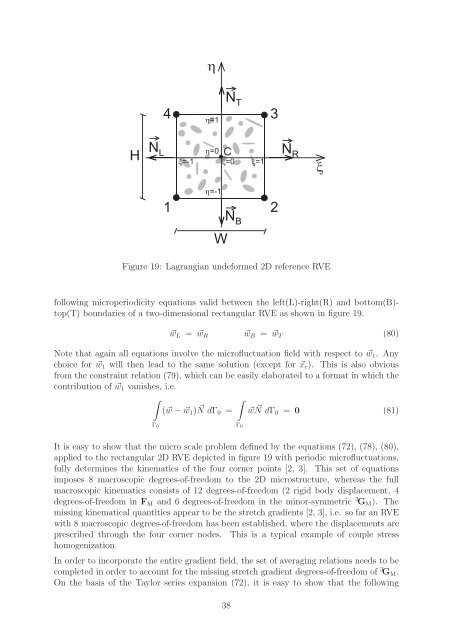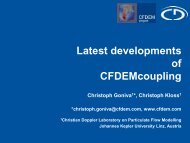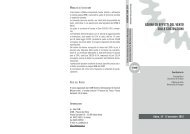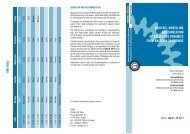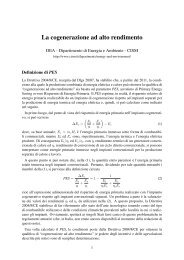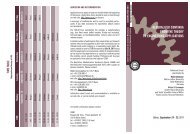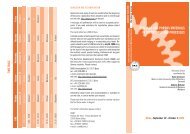Scale transitions in solid mechanics based on computational ... - Cism
Scale transitions in solid mechanics based on computational ... - Cism
Scale transitions in solid mechanics based on computational ... - Cism
- No tags were found...
You also want an ePaper? Increase the reach of your titles
YUMPU automatically turns print PDFs into web optimized ePapers that Google loves.
Figure 19: Lagrangian undeformed 2D reference RVEfollow<str<strong>on</strong>g>in</str<strong>on</strong>g>g microperiodicity equati<strong>on</strong>s valid between the left(L)-right(R) and bottom(B)-top(T) boundaries of a two-dimensi<strong>on</strong>al rectangular RVE as shown <str<strong>on</strong>g>in</str<strong>on</strong>g> figure 19.⃗w L = ⃗w R ⃗w B = ⃗w T (80)Note that aga<str<strong>on</strong>g>in</str<strong>on</strong>g> all equati<strong>on</strong>s <str<strong>on</strong>g>in</str<strong>on</strong>g>volve the microfluctuati<strong>on</strong> field with respect to ⃗w 1 . Anychoice for ⃗w 1 will then lead to the same soluti<strong>on</strong> (except for ⃗x c ). This is also obviousfrom the c<strong>on</strong>stra<str<strong>on</strong>g>in</str<strong>on</strong>g>t relati<strong>on</strong> (79), which can be easily elaborated to a format <str<strong>on</strong>g>in</str<strong>on</strong>g> which thec<strong>on</strong>tributi<strong>on</strong> of ⃗w 1 vanishes, i.e.∫∫(⃗w − ⃗w 1 ) NdΓ ⃗ 0 = ⃗w NdΓ ⃗ 0 = 0 (81)Γ 0 Γ 0It is easy to show that the micro scale problem def<str<strong>on</strong>g>in</str<strong>on</strong>g>ed by the equati<strong>on</strong>s (72), (78), (80),applied to the rectangular 2D RVE depicted <str<strong>on</strong>g>in</str<strong>on</strong>g> figure 19 with periodic microfluctuati<strong>on</strong>s,fully determ<str<strong>on</strong>g>in</str<strong>on</strong>g>es the k<str<strong>on</strong>g>in</str<strong>on</strong>g>ematics of the four corner po<str<strong>on</strong>g>in</str<strong>on</strong>g>ts [2, 3]. This set of equati<strong>on</strong>simposes 8 macroscopic degrees-of-freedom to the 2D microstructure, whereas the fullmacroscopic k<str<strong>on</strong>g>in</str<strong>on</strong>g>ematics c<strong>on</strong>sists of 12 degrees-of-freedom (2 rigid body displacement, 4degrees-of-freedom <str<strong>on</strong>g>in</str<strong>on</strong>g> F M and 6 degrees-of-freedom <str<strong>on</strong>g>in</str<strong>on</strong>g> the m<str<strong>on</strong>g>in</str<strong>on</strong>g>or-symmetric 3 G M ). Themiss<str<strong>on</strong>g>in</str<strong>on</strong>g>g k<str<strong>on</strong>g>in</str<strong>on</strong>g>ematical quantities appear to be the stretch gradients [2, 3], i.e. so far an RVEwith 8 macroscopic degrees-of-freedom has been established, where the displacements areprescribed through the four corner nodes. This is a typical example of couple stresshomogenizati<strong>on</strong>.In order to <str<strong>on</strong>g>in</str<strong>on</strong>g>corporate the entire gradient field, the set of averag<str<strong>on</strong>g>in</str<strong>on</strong>g>g relati<strong>on</strong>s needs to becompleted <str<strong>on</strong>g>in</str<strong>on</strong>g> order to account for the miss<str<strong>on</strong>g>in</str<strong>on</strong>g>g stretch gradient degrees-of-freedom of 3 G M .On the basis of the Taylor series expansi<strong>on</strong> (72), it is easy to show that the follow<str<strong>on</strong>g>in</str<strong>on</strong>g>g38


